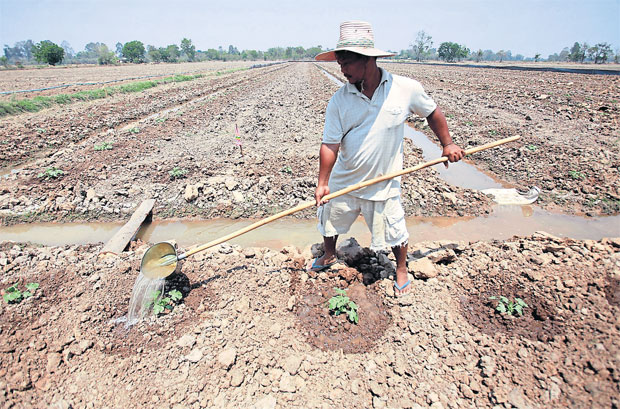
Farmers in Chai Nat province have switched from growing off-season rice to watermelon and kale after the worst drought in decades parched their rice fields. The farmers described the switch as a risk, but said growing rice would be worse.
A number of rice fields in Chai Nat's Muang, Sankhaburi, and Sapphaya districts have withered over a decade due to long-standing drought conditions in the central province. Even though scenic views of green vegetation can still be seen along some roadsides, many standing timbers such as mango trees have already wilted in the dryness.
Since the Royal Irrigation Department (RID) declared water will not be released to irrigation canals for the off-season rice farming, many farmers have decided not to till their farmland which was full of rice stubble from last year in preparation for off-season paddy cultivation.
- See also: Drought descends on the rice fields
Rice cultivation, therefore, will have to start again in the next rainy season.
Bunpote Keawthong, a 45-year-old farmer who opted to grow watermelon instead of rice, said it hasn't rained for about 10 months in his hometown, causing water shortages which affected rice farming. This year is the first time in a decade that residents haven't grown off-season rice.
He said most farmers in tambon Dong Kaun in Sankhaburi district did not cultivate off-season rice this year as a result of water shortages and a drop in the price of rice to between 6,000 and 7,000 baht per tonne. Nobody wanted to incur high initial investment costs and capital losses.
On top of water scarcity, locals have to contend with thousands of rats which eat and decimate crops on their farms.

A farmer in Chai Nat’s Sankhaburi district waters his watermelon plants. Several rice farmers in this central province have switched from growing rice to watermelons and kale, which require less water, as the province endures a serious drought. THANARAK KHUNTON
"It is difficult to find water in this season. Groundwater must be siphoned from boreholes. Villagers must also cope with the rats by electrocuting them every night," he said.
Mr Bunpote said the water he now uses on his farm has been pumped from the farmland of his neighbour, who has never demanded money from him.
Mr Bunpote said local people are willing to help each other. In such a dry season, kindness and sympathy are needed the most. Any extra expenses such as fuel costs or farm equipment maintenance will be shared among locals.
Even though rats are a big problem, Mr Bunpote said, an even bigger one is rice thrips, an insect pest that comes out during dry seasons and which can devastate the rice plants during the seedling stage.
If the rice thrips infest the plantation, almost 100% of that farm's crops will be destroyed.
Mr Bunpote, who now plants watermelons on five rai of land as his sideline crop, said the water which is siphoned from underground is not enough to supply the rice paddy, which risks dying. He has turned to short-lived plants instead.
"Watermelon is a short-lived plant and can be harvested and sold on the market after a couple of months of cultivation. But I still have to erect a tarp enclosure around my farm to prevent rats and rice thrips from getting in," he said.
Mr Bumpote said if he didn't learn how to plant other crops, he wouldn't be able to sustain himself and his family, due to the daily expenses.
He has to deduct the price of oil, used for a water pump, from his overall earnings. His monthly income ends up being only 10,000 baht.
"One of my farmer friends invested in a 14-rai watermelon farm worth around 100,000 baht. But he earned only about 20,000 baht due to low productivity," he added.
Some farmers planted beans but were unable to recoup their investment or make any profit, as the beans started to grow but eventually died.
Meanwhile, others have turned to growing corn as it requires less water than rice.
Kale and Chinese cabbage are other options for villagers as they can be harvested six weeks after planting and sold at eight baht per kilogramme.